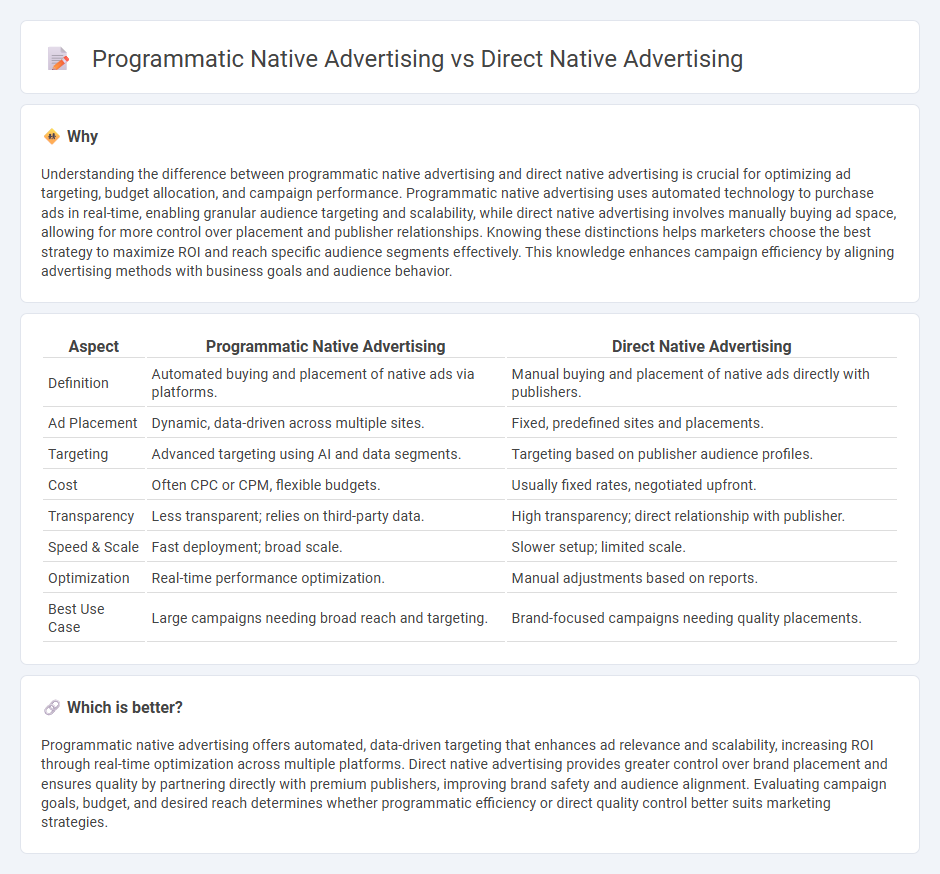
Programmatic native advertising uses automated technology to place ads in a way that matches the look and feel of the surrounding content, utilizing real-time bidding and audience targeting for efficiency and scale. Direct native advertising involves manual placement deals between advertisers and publishers, offering more control over ad context and brand safety. Explore the advantages and best practices of each approach to enhance your marketing strategy.
Why it is important
Understanding the difference between programmatic native advertising and direct native advertising is crucial for optimizing ad targeting, budget allocation, and campaign performance. Programmatic native advertising uses automated technology to purchase ads in real-time, enabling granular audience targeting and scalability, while direct native advertising involves manually buying ad space, allowing for more control over placement and publisher relationships. Knowing these distinctions helps marketers choose the best strategy to maximize ROI and reach specific audience segments effectively. This knowledge enhances campaign efficiency by aligning advertising methods with business goals and audience behavior.
Comparison Table
| Aspect | Programmatic Native Advertising | Direct Native Advertising |
|---|---|---|
| Definition | Automated buying and placement of native ads via platforms. | Manual buying and placement of native ads directly with publishers. |
| Ad Placement | Dynamic, data-driven across multiple sites. | Fixed, predefined sites and placements. |
| Targeting | Advanced targeting using AI and data segments. | Targeting based on publisher audience profiles. |
| Cost | Often CPC or CPM, flexible budgets. | Usually fixed rates, negotiated upfront. |
| Transparency | Less transparent; relies on third-party data. | High transparency; direct relationship with publisher. |
| Speed & Scale | Fast deployment; broad scale. | Slower setup; limited scale. |
| Optimization | Real-time performance optimization. | Manual adjustments based on reports. |
| Best Use Case | Large campaigns needing broad reach and targeting. | Brand-focused campaigns needing quality placements. |
Which is better?
Programmatic native advertising offers automated, data-driven targeting that enhances ad relevance and scalability, increasing ROI through real-time optimization across multiple platforms. Direct native advertising provides greater control over brand placement and ensures quality by partnering directly with premium publishers, improving brand safety and audience alignment. Evaluating campaign goals, budget, and desired reach determines whether programmatic efficiency or direct quality control better suits marketing strategies.
Connection
Programmatic native advertising and direct native advertising both focus on delivering personalized, contextually relevant ads that blend seamlessly with the content environment. Programmatic native advertising uses automated technology and real-time bidding to optimize ad placements across multiple platforms, while direct native advertising involves manual negotiations with publishers for premium placements. Both approaches aim to enhance user engagement by matching ad formats and messaging closely with the audience's interests and content consumption patterns.
Key Terms
Manual Placement
Direct native advertising involves manual placement where advertisers handpick specific websites or platforms to display their native ads, ensuring precise brand alignment and premium inventory access. Programmatic native advertising uses automated systems and algorithms to buy placements in real-time, optimizing reach and targeting but often sacrificing control over exact ad locations. Explore the benefits and challenges of manual placement in native advertising to refine your marketing strategy.
Real-Time Bidding
Direct native advertising offers precise brand control by placing content directly within relevant publisher environments, while programmatic native advertising utilizes Real-Time Bidding (RTB) to automate ad placements across multiple platforms, optimizing reach and targeting efficiency. RTB enables advertisers to bid on individual impressions in real time, leveraging data-driven algorithms to maximize campaign performance and audience engagement. Explore the intricacies of RTB to enhance your understanding of how native advertising can be strategically deployed for superior results.
Contextual Targeting
Direct native advertising ensures brand messages appear in highly relevant environments by negotiating placements directly with publishers, optimizing contextual alignment. Programmatic native advertising leverages AI and real-time data to dynamically place ads across a wide network of sites, improving scale but sometimes sacrificing precise contextual control. Explore deeper insights on how contextual targeting shapes the effectiveness of native advertising strategies to enhance your campaign outcomes.
Source and External Links
What Is Native Advertising? How It Works and Examples (2025) - Native advertising is paid media designed to match the form, function, and tone of the platform where it appears, blending seamlessly with organic content to engage audiences more effectively than traditional ads.
What is Native Advertising - How it Works - Outbrain - Native advertising involves creating high-quality content that matches the look and feel of the publisher's site, then distributing it through targeted campaigns on platforms used by your ideal audience.
What Is Native Advertising? The Ultimate Guide - Native ads are less intrusive, achieve higher engagement, and often outperform traditional display ads in click-through rates, purchase intent, and brand affinity by blending naturally with editorial content.
 dowidth.com
dowidth.com